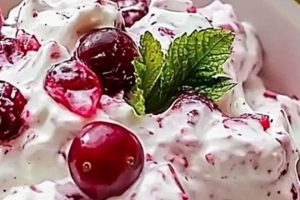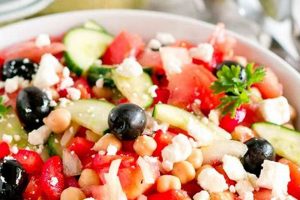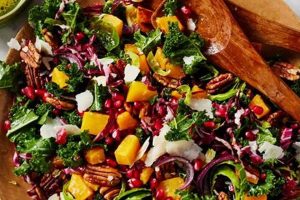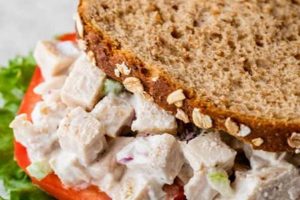Dishes categorized as “bound salads” refer to mixtures of ingredients, often chopped vegetables, fruits, proteins, or starches, held together by a thick dressing, typically mayonnaise-based, but sometimes vinaigrette-based or composed of other creamy sauces like yogurt or sour cream. Examples include classic potato salad, coleslaw, and tuna salad.
The cohesive nature provided by the dressing offers several culinary advantages. It allows for convenient transport and serving, making these salads ideal for picnics, potlucks, and buffets. The dressing also contributes to flavor development, marinating the ingredients and creating a harmonious blend of tastes and textures. Historically, such preparations arose from the need to preserve and enhance less flavorful ingredients or stretch limited resources. Today, they remain popular for their versatility, convenience, and satisfying flavors, often holding a nostalgic place in many cuisines.
This understanding of bound salads provides a foundation for exploring specific recipes, variations, and culinary techniques associated with their creation. Considerations such as ingredient selection, dressing preparation, and optimal chilling times all contribute to the final quality of the dish and will be examined further.
Tips for Creating Exceptional Bound Salads
Achieving optimal flavor and texture in bound salads requires attention to several key factors. The following tips offer guidance for creating dishes that are both delicious and visually appealing.
Tip 1: Ingredient Selection: Opt for fresh, high-quality ingredients. Consider the interplay of textures and flavors. Crisp vegetables, such as celery or bell peppers, complement softer ingredients like cooked potatoes or pasta.
Tip 2: Dressing Consistency: The dressing should be thick enough to bind the ingredients without making the salad soggy. Adjust the amount of binder (mayonnaise, yogurt, etc.) to achieve the desired consistency.
Tip 3: Flavor Balance: Balance richness with acidity. A touch of lemon juice or vinegar can brighten the flavors and prevent the salad from feeling too heavy. Incorporating herbs, spices, and seasonings enhances complexity.
Tip 4: Chilling Time: Allowing the salad to chill for at least 30 minutes, and preferably longer, allows the flavors to meld and the ingredients to absorb the dressing thoroughly. This chilling period enhances the overall taste and texture.
Tip 5: Ingredient Proportions: Strive for a balanced ratio of binder to other ingredients. Too much dressing can overwhelm the other flavors, while too little may result in a dry, unappealing salad.
Tip 6: Presentation: While flavor is paramount, presentation also plays a role. Consider garnishing the salad with fresh herbs, a sprinkle of paprika, or a few strategically placed ingredient pieces to enhance visual appeal.
Tip 7: Storage: Store leftover bound salad in an airtight container in the refrigerator for up to three days. Note that the texture may change slightly upon storage as ingredients continue to absorb the dressing.
By adhering to these guidelines, one can consistently produce bound salads that offer satisfying flavors and textures. Careful attention to detail elevates these seemingly simple dishes, transforming them into culinary highlights.
These tips provide a solid foundation for preparing a variety of bound salads. The following section offers specific recipe examples to further illustrate these principles.
1. Ingredients
Ingredient selection significantly impacts the overall quality and character of a bound salad. The interplay of flavors and textures determines whether the final product is harmonious and appealing. Consider a classic potato salad: waxy potatoes provide a creamy base, while crunchy celery and onion offer contrasting texture. Hard-boiled eggs contribute richness, and pickles or relish introduce a tangy counterpoint to the creamy dressing. These varied elements, when combined, create a complex and satisfying sensory experience. Substituting sweet potatoes for russets would yield a different flavor profile and texture, demonstrating how ingredient choices directly influence the final outcome.
Careful consideration should be given to ingredient compatibility. Some ingredients, like delicate greens, may wilt under the weight of a heavy dressing and are better suited for lighter vinaigrettes. Robust vegetables, such as diced bell peppers or carrots, hold up well in creamier, mayonnaise-based dressings. Furthermore, ingredient quality directly affects the overall flavor. Fresh, seasonal produce offers optimal flavor and texture, elevating the final dish. For example, using freshly cooked and properly chilled potatoes will yield a superior potato salad compared to using pre-cooked or improperly stored potatoes.
Ingredient selection serves as the foundation upon which a successful bound salad is built. Understanding the role and characteristics of each component allows for informed choices that contribute to the desired balance of flavors, textures, and overall appeal. The careful selection of ingredients ensures not only a palatable dish but also one that offers nutritional value and culinary satisfaction. This knowledge is crucial for adapting recipes, creating unique variations, and consistently achieving delicious results.
2. Binding Agent
The binding agent is the crucial component that transforms a collection of individual ingredients into a cohesive salad. It provides the structure and texture characteristic of bound salads, differentiating them from their tossed counterparts. The choice and proper utilization of the binding agent significantly influence the final product’s flavor, texture, and overall appeal.
- Role of the Binding Agent
The primary function of the binding agent is to coat the ingredients and adhere them together, creating a unified structure. This allows the salad to be easily served and transported, a key feature of bound salad recipes. Beyond its structural role, the binding agent contributes significantly to the flavor profile of the dish, often adding richness, creaminess, or tanginess.
- Common Binding Agents
Mayonnaise is the most prevalent binding agent, lending a classic creamy texture and flavor. Variations include aioli, Miracle Whip, and other flavored mayonnaises. Yogurt, sour cream, and crme frache offer lighter alternatives with tangier profiles. Less common, but equally viable options include hummus, guacamole, and pureed cooked vegetables.
- Factors Influencing Binding Agent Selection
The choice of binding agent depends on several factors, including the desired flavor profile, dietary restrictions, and the other ingredients in the salad. For example, a lighter vinaigrette-based dressing might be preferred for a delicate pasta salad, whereas a robust mayonnaise-based dressing complements a heartier potato or chicken salad. Vegan recipes often utilize plant-based alternatives like vegan mayonnaise or cashew cream.
- Achieving Optimal Consistency
The proper consistency of the binding agent is crucial. Too thin, and the ingredients will not adhere properly; too thick, and the salad becomes heavy and gloppy. The balance depends on the specific recipe and the ingredients involved. Often, the binding agent needs to be adjusted to account for the moisture content of other components, such as juicy tomatoes or watery cucumbers. Adding the dressing gradually and assessing the consistency allows for precise control and prevents an overly saturated salad.
Understanding the role and characteristics of the binding agent is fundamental to creating a successful bound salad. Its function extends beyond simply holding the ingredients together; it contributes significantly to the flavor, texture, and overall appeal of the dish. Careful selection and application of the binding agent, informed by the specific ingredients and desired outcome, are key to achieving a well-balanced and delicious result. This underscores the crucial role the binding agent plays in defining and elevating the bound salad experience.
3. Flavor Balance
Flavor balance is paramount in a successful bound salad recipe. The interplay of tastessweet, sour, salty, bitter, and umamicreates a harmonious and palatable experience. A well-balanced bound salad avoids monotony, offering a complexity that engages the palate. Consider the classic combination of potatoes, mayonnaise, celery, onion, and mustard in potato salad. The creamy richness of the potatoes and mayonnaise is balanced by the bright acidity of the mustard and the sharp notes of onion and celery. This interplay prevents the salad from being overly rich or bland, demonstrating the importance of flavor balance.
Achieving this balance often involves considering contrasting or complementary flavors. Acidity, often introduced through vinegar, lemon juice, or pickles, cuts through the richness of mayonnaise or other creamy binding agents. Sweetness, from ingredients like dried cranberries or apples, can temper savory elements. The judicious use of salt enhances other flavors and provides a foundational savory base. Herbs and spices add complexity and depth, further contributing to a well-rounded flavor profile. For example, a chicken salad might benefit from the addition of grapes for sweetness, tarragon for herbal complexity, and pecans for nutty richness, demonstrating the interplay of contrasting yet complementary elements. Ignoring flavor balance can result in a one-dimensional dish, overly sweet, excessively tart, or simply bland. The delicate interplay of these elements elevates the bound salad from a simple combination of ingredients to a nuanced and satisfying culinary experience.
Understanding flavor balance empowers one to create dynamic and enjoyable bound salads. It facilitates informed ingredient selection and allows for the purposeful adjustment of seasonings and other flavor components. This knowledge is crucial not only for following recipes but also for adapting them to personal preferences and creating unique variations. Mastery of flavor balance ultimately distinguishes an average bound salad from an exceptional one.
4. Texture
Texture plays a critical role in the overall enjoyment of a bound salad. A successful recipe incorporates a variety of textures to create a dynamic and engaging sensory experience. Consider the classic potato salad: the creamy texture of the potatoes contrasts with the crispness of celery and onion, while the slight chewiness of hard-boiled eggs adds another layer of textural complexity. This interplay prevents the salad from feeling monotonous and adds to its appeal. A solely creamy or solely crunchy salad would lack the same depth and satisfaction.
The interplay of textures can be achieved through a variety of techniques. Incorporating crunchy elements, such as nuts, seeds, croutons, or raw vegetables, provides contrast to softer components like cooked vegetables, pasta, or beans. The size and shape of ingredients also influence texture. Diced ingredients offer a different mouthfeel than shredded or sliced ones. Even the cooking method impacts texture; for example, roasted vegetables offer a firmer texture than boiled ones. A pasta salad, for instance, benefits from the addition of roasted vegetables and toasted nuts to complement the softer texture of the cooked pasta. Similarly, a chicken salad gains textural complexity from the inclusion of chopped celery, grapes, and walnuts.
Understanding the impact of texture is essential for creating well-balanced and appealing bound salads. It enables informed ingredient selection, preparation methods, and recipe development. Consideration of textural variety elevates the dining experience, transforming a simple combination of ingredients into a multi-faceted culinary creation. Failing to incorporate a range of textures can result in a dish that is either uninteresting or overwhelming to the palate, demonstrating the practical significance of textural balance in bound salad recipes.
5. Chilling Time
Chilling time is a crucial element in bound salad preparation, significantly impacting the final product’s flavor and texture. This period of refrigeration allows the flavors of individual ingredients to meld and harmonize, creating a more cohesive and complex taste profile. The binding agent, typically mayonnaise or a similar creamy base, also benefits from chilling. Lower temperatures allow the dressing to thicken and emulsify further, enhancing its ability to bind the ingredients together and create the desired textural consistency. Chilling also allows the ingredients to absorb the flavors of the dressing more thoroughly, resulting in a more unified and flavorful dish. For example, a potato salad allowed to chill overnight will exhibit a more pronounced flavor profile and firmer texture compared to one served immediately after mixing.
The practical implications of chilling time are substantial. Sufficient chilling minimizes the risk of bacterial growth, a crucial food safety consideration, especially for salads containing mayonnaise or dairy-based dressings. Additionally, proper chilling improves the structural integrity of the salad. Ingredients maintain their shape and texture better after chilling, preventing the salad from becoming watery or soggy. This is particularly relevant for picnics, potlucks, and other occasions where the salad may be served several hours after preparation. Ignoring chilling time can result in a bland, watery, and potentially unsafe dish, highlighting the importance of this often-overlooked step.
In conclusion, chilling time is not merely a suggestion but a vital component of a successful bound salad recipe. Its influence on flavor development, texture, and food safety is undeniable. Understanding the importance of this step and incorporating adequate chilling time into the preparation process significantly elevates the quality and safety of the final dish. This underscores the crucial connection between chilling time and the creation of a truly exceptional bound salad.
Frequently Asked Questions
This section addresses common inquiries regarding bound salad preparation, offering practical guidance for achieving optimal results.
Question 1: What is the ideal chilling time for a bound salad?
A minimum of 30 minutes is recommended, allowing flavors to meld. Optimal chilling time is typically 2-4 hours, or even overnight, for enhanced flavor development and texture.
Question 2: Can bound salads be frozen?
Freezing is generally not recommended. Mayonnaise-based dressings often separate upon thawing, resulting in an undesirable texture. Ingredients with high water content may also become mushy.
Question 3: How can one prevent a bound salad from becoming watery?
Thoroughly drain ingredients like potatoes and cucumbers before incorporating them into the salad. Ensure the dressing is the proper consistency, not too thin. Adequate chilling time also allows ingredients to absorb excess moisture.
Question 4: What are suitable alternatives to mayonnaise as a binding agent?
Yogurt, sour cream, and crme frache offer lighter options. Vegan alternatives include vegan mayonnaise or cashew cream. Hummus and guacamole provide unique flavor profiles and binding properties.
Question 5: How long can a bound salad be stored in the refrigerator?
Properly stored in an airtight container, a bound salad can typically last for 3-4 days in the refrigerator. However, the texture and flavor may change slightly over time.
Question 6: How can one enhance the flavor of a bound salad beyond basic seasonings?
Fresh herbs, spices, and aromatics like garlic or shallots add depth. Incorporating ingredients like olives, pickles, or capers provides bursts of flavor. A touch of acidity from lemon juice or vinegar brightens the overall profile.
Understanding these fundamental aspects contributes to successful bound salad preparation, resulting in dishes that are both flavorful and safe to consume. Proper chilling, ingredient selection, and attention to texture are crucial for achieving optimal results.
This concludes the frequently asked questions section. The following segment will provide a selection of classic bound salad recipes.
Conclusion
Preparation of successful bound salads involves a careful orchestration of several key elements. Ingredient selection influences flavor profiles and textural complexity. The binding agent provides structure and contributes to overall taste and consistency. A harmonious flavor balance, achieved through acidity, sweetness, and savory notes, is essential. Attention to textural variety enhances the eating experience. Finally, adequate chilling time allows flavors to meld, textures to set, and food safety standards to be met. These interconnected factors contribute to the creation of a complete and satisfying culinary experience.
Bound salads, though seemingly simple, offer a platform for culinary creativity and exploration. Understanding the foundational principles outlined herein allows for recipe adaptation, ingredient substitution, and the development of unique variations. This knowledge empowers culinary enthusiasts to elevate the bound salad from a humble side dish to a star attraction. Further exploration of regional variations and cultural adaptations offers boundless opportunities for culinary discovery and innovation within this versatile category.






